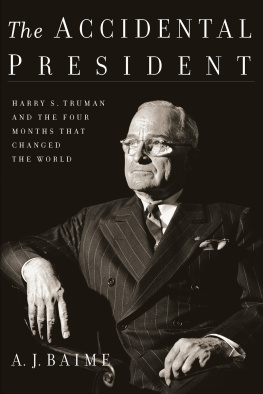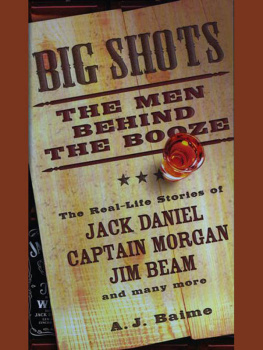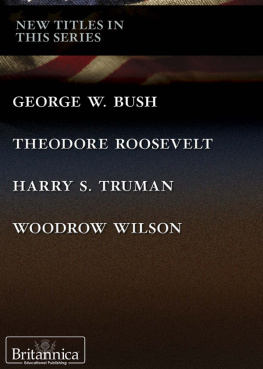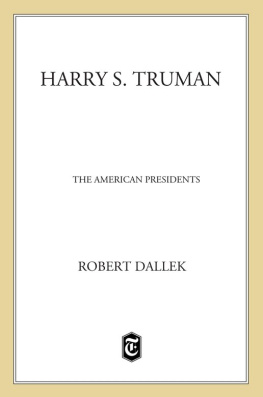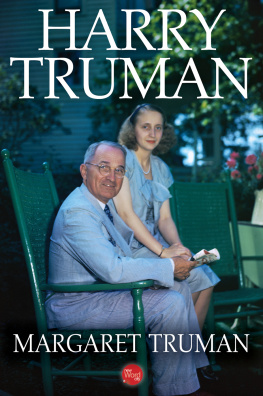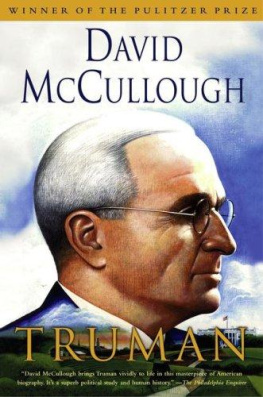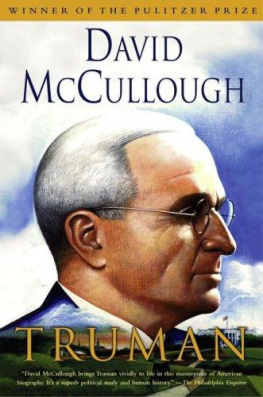Copyright 2017 by Albert Baime
All rights reserved
For information about permission to reproduce selections from this book, write to or to Permissions, Houghton Mifflin Harcourt Publishing Company, 3 Park Avenue, 19th Floor, New York, New York 10016.
hmhco.com
Library of Congress Cataloging-in-Publication Data is available.
ISBN 978-0-544-61734-6
Cover design by ArchieFergusonDesign.com
Cover photograph Katherine Young/Getty Images
Author photograph Rob Williamson
e ISBN 978-0-544-61848-0
v2.1017
For Judge David S. Baime,
my father,
who has kept a portrait of
Harry S. Truman on his office wall
for more than forty years
Introduction
FEW AMERICAN PRESIDENTS have left such a polarizing legacy as Harry Truman. Perhaps none have. Historians have ranked him among the greatest and among the worst chief executives. His administration was deeply frowned upon when he left office in January 1953. Less than ten years later, a poll conducted by the prominent historian Arthur Schlesinger ranked Truman ninth among American presidents. As recently as 2014, a Washington Post poll ranked him sixth. At the same time, others have labeled him a war criminal, for it was Truman who gave the go-ahead to drop the atomic bombs on JapanLittle Boy and Fat Man, August 6 and 9, 1945.
This book poses a new thesis. Regardless of Trumans legacy, the first four months of his administration should rank as the most challenging and action-packed of any four-month period in any American presidency. Through declassified war documents, personal diaries, international communications of the highest diplomacy, and other primary sources, the figures who appear in this book will tell you that themselves. Arguably, no other four-month period has had so much import in shaping the world we live in today.
Trumans presidential odyssey began on April 12, 1945, the day Franklin Roosevelt died. It is impossible to understate the shock to the world FDRs death caused. The Romans must have felt this way when word came that Caesar Augustus was dead, the columnist I. F. Stone wrote at the time. Perhaps not since the dawn of history, State Department veteran Joseph Davies wrote in his diary, has the passing of a great man been mourned contemporaneously by so many different nations, so many different religions and races, spread over the earth.
Roosevelt had played the role of chief executive as if history had written it for him. Prestige was his defining characteristic, in an age when Victorian values and class structure still dictated so much of peoples lives. He served as president longer than any other man, and was the first to be widely considered one of the all-time great American presidents during his administration. (Washington, Jefferson, and Lincoln all found their places in the canon of greats after their deaths.) In a 1945 Gallup poll, in which Americans were asked to name world historys greatest figure, the country put Roosevelt first, ahead of Abraham Lincoln and Jesus Christ.
The man forced to fill his shoesTruman, the vice presidentwas the prototypical ordinary man, in contrast. He had no college degree. He had never had enough money to own his own home. He had never governed a state or served as mayor of a city. He became president by accident (his words). His ascendancy to the most powerful office in existence was the result of a confluence of almost bizarre events, and his obscurity confounded the world.
Here was a man who came into the White House almost as though he had been picked at random off the street, recalled Robert Nixon, a Truman White House correspondent, with absolutely no useable background and no useable information. Here was a guy like you, or your next door neighbor, one of Trumans closest friends, Harry Vaughan, said, and he got into a job that was too big for him. When Truman took office, a Chicago Tribune columnist spoke for all of civilized humanity when he wrote: All the world is asking two questions. What sort of man is Harry S. Truman? and What kind of president will he make?
The first four months of Trumans presidency saw the collapse of Nazi Germany, the founding of the United Nations, firebombings of Japanese cities that killed many thousands of civilians, the liberation of Nazi death camps, the suicide of Adolf Hitler, the execution of Benito Mussolini, and the capture of arch war criminals from Hitlers number two, Hermann Gring, to the Nazi chief werewolf Ernst Kaltenbrunner. There was the fall of Berlin, victory at Okinawa (which the historian Bill Sloan has called the deadliest campaign of conquest ever undertaken by American arms), and the Potsdam Conference, during which the new president sat at the negotiating table with Winston Churchill and Joseph Stalin in Soviet-occupied Germany, in an attempt to map out a new world. Humanity saw the first atomic explosion, the nuclear destruction of Hiroshima and Nagasaki, the dawn of the Cold War, and the beginning of the nuclear arms race.
Never had fate shoehorned so much history into such a short period. The four months that have elapsed since the death of President Roosevelt on April 12 have been one of the most momentous periods in mans history, wrote a New York Times columnist at the time. They have hardly any parallel throughout the ages.
This book is not a full-length biography of Truman, nor is it a study of the decision to drop the atomic bomb, for those books have been written. It is rather an intimate biographical portrait of Truman during the first four months of his administrationthe climactic months of World War II. It was a time when Americans achieved a sense of unity that seems unimaginable today. It was also a time of massacre, when the U.S. military committed acts it still struggles to justify more than seventy years later. New documents have appeared for research since the wave of Truman biographies was published nearly a quarter century ago. Also, the early days of the Truman administration seem particularly relevant given the global political picture today and all the debate about what the American presidency has or should become.
Whether or not the reader accepts my thesis is obviously subjective. Each can decide at the end. But first, there must be a beginning: April 12, 1945.
Timeline
The Rise of Truman
MAY 8, 1884:Harry S. Truman is born in rural Lamar, Missouri.
1901:Truman graduates high school. Due to lack of funds, he does not go to college. He works through a series of jobs, on a railroad and then as a clerk at Kansas City banks.
19061917:Truman returns to the family farm in Grandview, Missouri, where he will toil obscurely for eleven years. Get-rich-quick schemesfrom oil wells to mining operationsall end in failure.
1918: APRIL 13:Truman lands in France as a thirty-three-year-old captain in the U.S. Army during World War I.
JULY 11:He takes command of Battery D.
NOVEMBER 11:World War I ends. While more than 5 million Allied soldiers have been killed, including roughly 117,000 Americans, Trumans Battery D does not lose a single man.
JUNE 28, 1919:Truman marries Elizabeth Bess Wallace and moves into her family home in Independence, Missouri.
1922:Truman and Jacobson, a Kansas City haberdashery, fails, leaving Truman financially devastated.
With virtually no qualifications, Truman wins an election for a judgeship in rural Jackson County, due to the backing of Tom Pendergastthe corrupt boss of Kansas Citys Democratic machine.
1924:Truman fails in his bid for reelection. It is the only election he will ever lose.
1926:Truman wins election for presiding judge of Jackson County, again due to the patronage of Boss Tom Pendergast.
Next page
